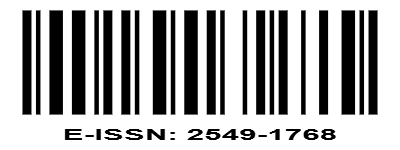DIVERSITY OF TREE SPECIES IN SYIAH KUALA UNIVERSITY
DOI:
https://doi.org/10.22373/biotik.v10i1.13030Keywords:
Species Diversity Index, Important Value, FloraAbstract
This research was conducted from April 2020 to October 2020 entitled "Diversity of Tree Species at Syiah Kuala University". The data collection technique was performed through a survey of 21 observation plots including faculties, office units, worship facilities, health facilities and other supporting facilities. The data analysis includes the Important Value (NP) and Species Diversity Index (H'). The results showed that the species composition of trees growing on the campus of Syiah Kuala University were 46 species belonging to 27 families. Six tree species that had relatively high importance value compared to others, namely Pterocarpus indicus (19.61%), Swietenia mahagoni (19.56%), Polyathia longifolia (12.76%), Mimusops elengi (12.48%), Roystonia regia (12.27%), and Samanea saman (10.176%). The Diversity Index (H') of those tree species ranged from 1.549 to 2.634. The conclusion is that the tree species composition was relatively limited when compared to the Cronquist classification, and the tree species diversity index was in the medium category.Downloads
References
Rushayati, S.B., Hadi, S.A., Endes N.D., & Herry, P. 2011. Pengembangan Ruang Terbuka Hijau Berdasarkan Distribusi Suhu Permukaan di Kabupaten. Bandung. Forum Geografi. Vol 25(1): 17-26.
Rahmy, W.A., Budi, F., & Agus, R.S. 2012. Kebutuhan Ruang Terbuka Hijau Kota pada Kawasan Padat, Studi Kasus di Wilayah Tegallega, Bandung. Jurnal Lingkungan Binaan Indonesia. Vol 1(1): 27-38.
Sundari, E.S. 2007. Studi untuk Menentukan Fungsi Hutan Kota dalam Masalah Lingkungan Perkotaan. Jurnal Perencanaan Wilayah dan Kota Unisba. Vol. 7(2):86-83
Joga, N. & Ismaun, I. 2011. RTH 30% Resolusi Kota Hijau. PT Gramedia Pustaka Utama: Jakarta.
Astriani, Nadia. 2014. Implikasi Kebijakan Ruang Terbuka Hijau dalam Penataan Ruang di Jawa Barat. Jurnal Ilmu Hukum. Vol 8(2): 242-254.
Mochamad, Z.A., Rohlan, R., & Siti, N.R.I. 2015. Kajian Fungsi Ruang Terbuka Hijau Fakultas Pertanian Universitas Gadjah Mada. Jurnal Vegetalika. Vol. 4(1): 16-28.
Syafei, E.S. 1994. Pengantar Ekologi Tumbuhan. ITB, Bandung.
Barbour,M. G, JH Burk, WD Pitts, Gilliam FS, Schwartz MW. 1999. Terrestrial Plant Ecology. 3 rd ed. Benjamin Cummings, Menlo Park, CA.
Cox, GW. 2001. Laboratory Manual of General Ecology. WM. C Brown Company Publisher, New York.
Mueller-Dombois, D and H. Ellenberg. 2016. Goals and Methods of Vegetation Ecology. Translated by Kuswata Kartawinata and Rochadi Abdulhadi. LIPI Press: Jakarta.
Ismaini, Lily., Masfiro L., Rustandi & Dadang S. 2015. Analisis Komposisi dan Keanekaragaman Tumbuhan di Gunung Dempo, Sumatera Selatan. Jurnal Biodiv Indon. Vol. 1(6):1397-1402
Irwan, Z.D. 1992. Prinsip-prinsip Ekologi dan Organisasi Ekosistem, Komunitas dan Lingkungan. Jakarta: Bumi Aksara.
Djufri, Wardiah, ZA Muchlisin. 2016. Plants diversity of the deforested peat-swamp forest of Tripa, Indonesia. Biodiversitas 17: 372-376.
Indriyanto. 2006. Forest Ecology. PT Bumi Aksara.
Djufri. 2003. Vegetation Analysis of Spermatophyte in Green Forest Park Seulawah, Aceh Besar. Biodioversitas 4: 30-34 [Indonesian].
Djufri, Edi, G., Dede, S., Ibnu, Q. 2006. Effect invasion and autecology study of acacia (Acacia nilotica) (L.) Will. ex Del. against Savana's existence and the handling strategy at Baluran Banyuwangi National Park of East Java. Dissertation. Post Graduate Program Bachelor of Bogor Agricultural University: unpublished [Indonesian].
Downloads
Published
Issue
Section
License
Authors who publish with BIOTIK: Jurnal Ilmiah Biologi Teknologi dan Kependidikan agree to the following terms:
- Authors retain copyright and grant the journal right of first publication with the work simultaneously licensed under a Creative Commons Attribution License that allows others to share the work with an acknowledgement of the work's authorship and initial publication in this journal.
- Authors are able to enter into separate, additional contractual arrangements for the non-exclusive distribution of the journal's published version of the work (e.g., post it to an institutional repository or publish it in a book), with an acknowledgement of its initial publication in this journal.
- Authors are permitted and encouraged to post their work online (e.g., in institutional repositories or on their website) prior to and during the submission process, as it can lead to productive exchanges, as well as earlier and greater citation of published work.











